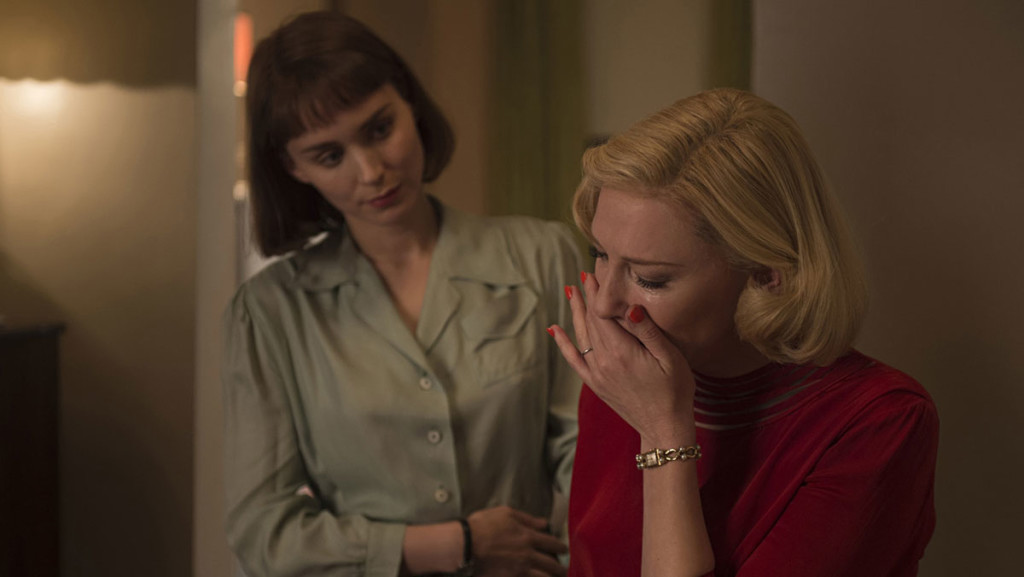A young man strides into the bar of an upscale hotel. He orders a drink and restlessly scans the room. His gaze lands on two women sitting in the adjacent lounge, one of whom he recognizes as a former colleague. He goes to say hello and convinces her to accompany him to a party later that night. The women proceed to go their separate ways, but not before the elder of the two rests a parting hand on her tablemate’s shoulder. Neither the man nor the audience is aware that these two women are more than just old friends.
Powerfully moving and visually stunning, “Carol” connects with viewers on an emotional level rarely seen in this day and age. Based on Patricia Highsmith’s 1952 novel “The Price of Salt” and adapted for the screen by dramatist Phyllis Nagy, the film stars Rooney Mara as Therese Belivet, an amateur photographer who dreams of a more fulfilling life from behind the doll counter of a Manhattan department store. When she sees Carol Aird (Cate Blanchett), a suburban socialite intent on buying her daughter a Christmas gift, walk into this world of manufactured luxury, an immediate connection sparks between them. But what starts as a friendship becomes a torrid love affair that promises to forever change the course of their lives.
Director Todd Haynes marks his return to the familiar territory of 1950s-set melodramas by choosing to explore the topic of homosexual relationships from the perspective of the star-crossed lovers. The dreamlike cinematography and haunting score work in perfect synchronization to turn every moment that Therese shares with Carol into a highly charged act of foreplay. This slow-burn approach not only keeps the audience members on the edge of their seats, but also constantly leaves them wondering if the forbidden lovers will consummate their romance. Although the plot is eerily similar to that of Haynes’ 2002 film “Far from Heaven,” which follows a homemaker whose seemingly perfect life slowly falls apart, the cast and crew manage to prove that “Carol” is more than just a tried-and-true story with a fresh coat of paint.
Blanchett’s portrayal of the titular protagonist, which recently earned the actress her seventh Academy Award nomination, is perhaps her best performance to date. She captures Carol’s inner sadness with such elegance and grace that she transforms into the character she’s playing.
Mara equally shines as Therese, crafting a memorable performance that deserves the Academy Award for Best Actress in a Supporting Role. There is a vulnerability to everything she does, one that fades away as the film progresses, and Therese blossoms into an independent young woman.
The members of the supporting cast add color to the unforgiving climate in which the film is set. Kyle Chandler is an effective force as Carol’s neglectful spouse, as is Jake Lacy, who plays Therese’s overeager boyfriend. “American Horror Story” veteran Sarah Paulson captivates viewers in a minor role as Abby, a woman who knows Carol better than anyone else. Cory Michael Smith rounds out the cast as a traveling salesman whose purpose is to serves as a catalyst into the film’s harrowing final act.
Academy Award–winning costume designer Sandy Powell, who worked alongside Haynes on both “Far from Heaven” and his 1998 film “Velvet Goldmine,” adds her signature touch to the film, creating true-to-the-era costumes that work in conjunction with Heather Loeffler’s set designs and bring New York City in the 1950s to life on screen. Cinematographer Edward Lachman stays true to the period by choosing to shoot “Carol” on Super 16 mm film instead of 35 mm, framing each scene with careful precision and giving the final product an ethereal quality.
A masterful blend of acting and filmmaking, “Carol” is unlike anything on the big screen right now. It offers a refreshing take on same-sex relationships and is sure to shed a little more light on the issue of equality in the world today.
“Carol” was directed by Todd Haynes and written by Phyllis Nagy.




















